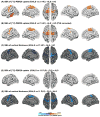Integrated magnetic resonance imaging and [11 C]-PBR28 positron emission tomographic imaging in amyotrophic lateral sclerosis
- PMID: 29740862
- PMCID: PMC6105567
- DOI: 10.1002/ana.25251
Integrated magnetic resonance imaging and [11 C]-PBR28 positron emission tomographic imaging in amyotrophic lateral sclerosis
Abstract
Objective: To characterize [11 C]-PBR28 brain uptake using positron emission tomography (PET) in people with amyotrophic lateral sclerosis (ALS) and primary lateral sclerosis (PLS). We have previously shown increased [11 C]-PBR28 uptake in the precentral gyrus in a small group of ALS patients. Herein, we confirm our initial finding, study the longitudinal changes, and characterize the gray versus white matter distribution of [11 C]-PBR28 uptake in a larger cohort of patients with ALS and PLS.
Methods: Eighty-five participants including 53 with ALS, 11 with PLS, and 21 healthy controls underwent integrated [11 C]-PBR28 PET-magnetic resonance brain imaging. Patients were clinically assessed using the Upper Motor Neuron Burden (UMNB) and the Amyotrophic Lateral Sclerosis Functional Rating Scale-Revised (ALSFRS-R). [11 C]-PBR28 uptake was quantified as standardized uptake value ratio (SUVR) and compared between groups. Cortical thickness and fractional anisotropy were compared between groups and correlated with SUVR and the clinical data. [11 C]-PBR28 uptake and ALSFRS-R were compared longitudinally over 6 months in 10 ALS individuals.
Results: Whole brain voxelwise, surface-based, and region of interest analyses revealed increased [11 C]-PBR28 uptake in the precentral and paracentral gyri in ALS, and in the subcortical white matter for the same regions in PLS, compared to controls. The increase in [11 C]-PBR28 uptake colocalized and correlated with cortical thinning, reduced fractional anisotropy, and increased mean diffusivity, and correlated with higher UMNB score. No significant changes were detected in [11 C]-PBR28 uptake over 6 months despite clinical progression.
Interpretation: Glial activation measured by in vivo [11 C]-PBR28 PET is increased in pathologically relevant regions in people with ALS and correlates with clinical measures. Ann Neurol 2018;83:1186-1197.
© 2018 American Neurological Association.
Conflict of interest statement
No conflicts to report.
Figures






References
-
- Sargsyan SA, Monk PN, Shaw PJ. Microglia as potential contributors to motor neuron injury in amyotrophic lateral sclerosis. Glia. 2005;51(4):241–253. - PubMed
-
- Boillee S, Yamanaka K, Lobsiger CS, et al. Onset and progression in inherited ALS determined by motor neurons and microglia. Science. 2006;312(5778):1389–1392. - PubMed
-
- Henkel JS, Beers DR, Siklos L, Appel SH. The chemokine MCP-1 and the dendritic and myeloid cells it attracts are increased in the mSOD1 mouse model of ALS. Mol Cell Neurosci. 2006;31(3):427–437. - PubMed
Publication types
MeSH terms
Substances
Grants and funding
LinkOut - more resources
Full Text Sources
Other Literature Sources
Medical
Miscellaneous

